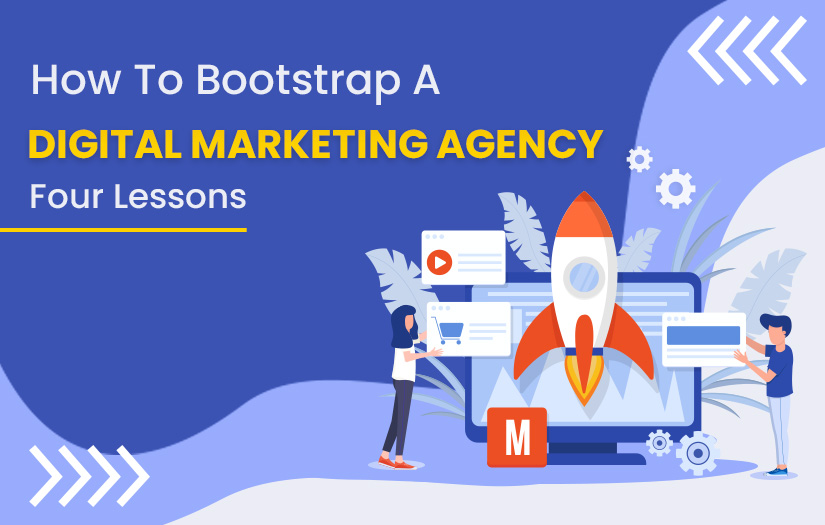Bootstrapping is usually a must for any new Digital Marketing Agency. Banks won’t lend you a penny without a long history of accomplishment, and venture capitalists aren’t waiting to offer millions of dollars in capital rounds to agencies.
The dominance of digital advertising is undeniable. As per Statista, in the US, ad agencies’ revenue from digital sources skyrocketed from 30% in 2011 to over 64% in 2021. This trend suggests online advertising has ample room for further growth, especially considering the shift in consumer behavior post-COVID-19.
The reality is that lots of companies fail. The majority of the time, whether you win or lose, it’s not about your abilities. It’s all about how long you’ll be able to survive with just a little cash that’s bootstrapped until you can build the necessary momentum.
I’m confident because I went through this situation. To help you conquer this obstacle, I’ve put together four lessons that I learned from my own experience of bootstrapping my agency.
Lesson 1: Finding the Right Client
It’s pretty obvious, isn’t it? But I’ve learned from the beginning how bad customers can drag your business down. They can cause tension and can cause a rift in your team, and they usually aren’t generating any income for you. Make sure that every new client you sign up for is a good fit for your agency.
This may not seem like an obvious idea for a bootstrapping strategy. Many people believe that bootstrapping is merely dependent on personal earnings as well as sweat equity. For me, it all came down to making the most out of our current circumstances.
This was an extremely difficult lesson to master. As you begin, it’s tempting to go on to every single client who is offering to ensure cash flow in the place. However, for me, this is the structure of a curved economy. I’ve had a number of unhappy clients over the years, and now I’m here to say that all they do is bring your company down after a certain time.
Being able to identify the indications of a problematic client early can protect your Digital Marketing Agency from problems like these. One of the warning signs to look out for is the possibility of scope creep, or the pressure to perform more work than the client agreed to pay for. I’m fine with clients on a tight budget, so long as we are able to agree on the work to be done at the rate that is agreed upon.
I’ve noticed that those who attempt to circumvent this tend to be disrespectful in different ways. Another danger for me, as the founder of a Digital Marketing Agency, is that clients aren’t sure what they’re looking to achieve. It’s difficult to assist a customer in achieving results when they aren’t sure what they’re looking for.
Lesson 2: Be Smart with Your Money
Every business must be cash-conscious. However, one of the challenges you could face when working with a Digital Marketing Agency is that there will be employees as well as team members that are aware of what the superb tech offices across the globe are like, and often, they’ll expect the same thing from you.
However, perks aren’t the only thing that can benefit the company. Do not fall into the trap of decking offices with all kinds of tech and trendy games such as foosball. Consider going completely remote, just like we did. Cash flow is very crucial in bootstrapping, and you don’t need to waste money on office equipment.
Lesson 3: Hire Team Members That Are able to embrace different specialties
Expanding your Digital Marketing Agency requires making sure that you have the right people. It can also cost you money. You require people who know their stuff, but those who have years of experience could become expensive quickly.
As I was expanding my company, we sought people who could be a part of various specialties while working with each other (and we frequently brought these individuals on as contractors, rather than full-time staff). The lead for search engine optimization worked closely with the content lead they would collaborate closely in conjunction with an outreach group, and the list goes on.
It may seem strange to have designers working on outreach with their team, however, the information they acquire is valuable. The fact that team members are so closely connected to one another’s work will allow you to create an effective team that can work with each other and is aware of how their work is tied to the work of other people.
Lesson 4: Pay Attention to Training and Onboarding
At the beginning of my agency, I invested a lot of time in developing training and onboarding materials, which is one of my most memorable actions for the business.
When you’re first starting out, it’s difficult to complete everything. Founders take on the responsibility, and they handle the client work, manage human resources, and are the first point of contact for clients and employees. The creation of training and onboarding materials, in the beginning, helped me to break out of this cycle. With my first collection of training materials, I could train my team members in the direction I would like the agency to adopt. Once they had been taught, they were capable of taking over the training of the next batch of employees, this allowed me to remove myself, and make time for other initiatives.
Some of the materials I developed earlier for the training purpose, included checklists on:
- Create content
- Content promotion
- Not calling in sick or scheduling vacation time
- How do you answer the phone calls
- How to conduct an SEO audit
This isn’t the complete list of resources I’ve created, but I believe you’ll have an idea. In the final analysis, set your intention to record your onboarding and training processes to ensure that team members won’t need to repeatedly ask the same questions over and over. The process is all documented for them.
Why go for Bootstrapping?
Bootstrapping isn’t easy though, the control and freedom it offers are unexampled. It forces you to focus quickly on the strengths of your competitors to begin developing them into revenue. Companies that aren’t able to differentiate themselves tend to fade away quickly regardless of the number of funds they have at first.
Hustle. Iterate. Keep your finances in check until you can afford to take on a bigger project. At the end of the day, you’ll probably be happy that you have bootstrapped your way to success.
As a digital marketing agency, we understand the challenges of bootstrapping a new venture in the competitive landscape of digital marketing. Our expertise lies in providing comprehensive support to budding entrepreneurs like you. From crafting a compelling brand identity to developing a robust online presence, we offer tailored solutions to suit your specific needs and budget constraints. Our services encompass everything from website development and search engine optimization (SEO) to social media marketing and content creation. With our guidance, you can effectively navigate the digital realm, establish your brand, and reach your target audience with maximum impact.






